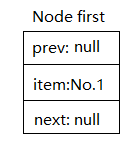心在山东身在吴,飘蓬江海漫嗟吁。
他时若遂凌云志, 敢笑黄巢不丈夫。
——水浒传
先上源代码,LinkedList类:
1 private static class Node<E> { 2 E item; 3 Node<E> next; 4 Node<E> prev; 5 6 Node(Node<E> prev, E element, Node<E> next) { 7 this.item = element; 8 this.next = next; 9 this.prev = prev; 10 } 11 }
Java链表中定义了一个内部类Node类,"node"是节点的意思.链表的基本元素是节点,(双向链表)每个节点包含三个成员,分别是item:数据,next:指向链表下一个元素的指针,prev:指向上一个元素的指针
先看一下C中的链表:

头指针变量保存了一个地址,它指向一个变量No.1,No.1中又保存了一个指针,它指向No.2,以此类推,直到No.X中保存的地址指向No.last,图中最后一项为No.3,它指向NULL。
双向链表每个元素中又加入了prev指针。
双向链表图:

但是java中没有指向内存地址的指针,那么如何实现链表呢?
再看Java源代码:

1 transient int size = 0; 2 3 /** 4 * Pointer to first node. 5 * Invariant: (first == null && last == null) || 6 * (first.prev == null && first.item != null) 7 */ 8 transient Node<E> first; 9 10 /** 11 * Pointer to last node. 12 * Invariant: (first == null && last == null) || 13 * (last.next == null && last.item != null) 14 */ 15 transient Node<E> last; 16 17 /** 18 * Constructs an empty list. 19 */ 20 public LinkedList() { 21 } 22 23 /** 24 * Constructs a list containing the elements of the specified 25 * collection, in the order they are returned by the collection's 26 * iterator. 27 * 28 * @param c the collection whose elements are to be placed into this list 29 * @throws NullPointerException if the specified collection is null 30 */ 31 public LinkedList(Collection<? extends E> c) { 32 this(); 33 addAll(c); 34 }
LinkedList类定义了两个临时节点first和last,两个构造器.一个无参构造和一个带参构造,无参构造创建链表实例,带参构造可以把一个集合整体加入链表
下面看一下add()方法:
1 public boolean add(E e) { 2 linkLast(e); 3 return true; 4 }
1 void linkLast(E e) { 2 final Node<E> l = last; 3 final Node<E> newNode = new Node<>(l, e, null); 4 last = newNode; 5 if (l == null) 6 first = newNode; 7 else 8 l.next = newNode; 9 size++; 10 modCount++; 11 }
画图:
初始链表为空的情况:prev和next都是null,item是e,这里假设传入的数据是No.1,No.2...;

此时再加入元素:

加入第三个元素:

加入第四个元素:

以此类推。。。
可见java中链表是用引用变量指向节点来代替C中的指针变量指向内存地址。
每次加入新的元素,只需要将原last元素的next指向新加入元素的实例,把新加入元素的prev指向原last元素的实例。
再看下add(int index, E element)方法:
1 public void add(int index, E element) { 2 checkPositionIndex(index); 3 4 if (index == size) 5 linkLast(element); 6 else 7 linkBefore(element, node(index)); 8 }
1 Node<E> node(int index) { 2 // assert isElementIndex(index); 3 4 if (index < (size >> 1)) { 5 Node<E> x = first; 6 for (int i = 0; i < index; i++) 7 x = x.next; 8 return x; 9 } else { 10 Node<E> x = last; 11 for (int i = size - 1; i > index; i--) 12 x = x.prev; 13 return x; 14 } 15 }
这里假定传入的index比size小,
node(int index)用很简单的方式返回了位置为index的Node实例,然后执行linkBefore(E e, Node<E> succ)方法
1 void linkBefore(E e, Node<E> succ) { 2 // assert succ != null; 3 final Node<E> pred = succ.prev; 4 final Node<E> newNode = new Node<>(pred, e, succ); 5 succ.prev = newNode; 6 if (pred == null) 7 first = newNode; 8 else 9 pred.next = newNode; 10 size++; 11 modCount++; 12 }
把newNode 的prev 指向原位置节点的prev节点,next 指向原位置节点;
把原位置节点的prev指向newNode;
最后把原位置节点的prev节点(如果有)的next指向newNode;如果没有,则newNode为第一个节点,原位置节点变为第二个节点;
此处省略其他链表方法...原理是一样的.
